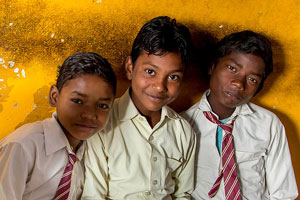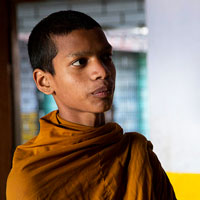| |
English / Deutsch |
| |
English / Deutsch |


Frequently Asked Questions How did the school start?
In 1989, during the annual Insight Meditation retreat at the Thai Monastery with Christopher Titmuss, one Indian monk living there, Venerable Anuruddha, was working in the Monastery with very poor children from the local village. He was teaching them some simple chanting, some basic Dharma and basic alphabet. Children came half naked, dressed in rags in the cold January winter in Bodhgaya. Little ones would often carry their younger brother or sister. It was very touching, and many of the retreatants took an interest in these kids, giving them fruit, biscuits and clothes. Venerable Anuruddha said he would like to hire two teachers who could teach the children some basic subjects, like Hindi, math, and English, just for a couple hours a day. So people on the retreat raised $100 to hire the teachers to pay them $4 per month.
The following January, in 1990, the money had not been spent. Instead Ven Anuruddha had formed a committee, with Kabir Saxena from the Root Institute and others, to start a school in another local village. Ven Anuruddha explained that the people from Mastipur had requested him to start a school there as they had no school and most people in their village were illiterate.
This committee rented a room in the local Sakya Tibetan Temple from the 1st March 1990. They hired 2 local teachers, Preyag Prajapati and Sumitra Devi, paying them very small salaries. There was an opening day ceremony at the Temple and Lama Zopa Rinpoche blessed the new school. Twenty five of the poorest children from the village had been enrolled but when classes started, forty children showed and none were turned away.
The school had to leave the Sakya Temple when the pilgrimage season started in the autumn and was moved into a house in the village. In March 1991, a second class was added and the school moved again, this time to 2 dormitory rooms in the Root Institute. The school stayed there until funds were raised to buy a small piece of land where our school is presently located. Two tents were erected and these became the classrooms.
How did the school go from classes in two tents to what it is now?
In 1991 it had become clear that the fledgling school was filling a need. An appeal for funds was made at the end of the Bodhgaya Insight Meditation retreats. Christopher Titmuss, based in the UK started raising funds, as did Felix Helg in Switzerland. A small group of friends in Australia started a group called the Bodhgaya Development Association, with the primary aim of raising funds for the school and other programs in Bodhgaya. These three: two individuals and one small group of usually six people, were to become the main fundraisers for twenty years.
Finding a local person we could trust and afford to be principal didn't seem possible, so the decision was made in 1993 to invite a local order of Catholic nuns, called the Queen of the Apostles, to run the school, in so far as providing a principal and deputy for a multi-religious school. The sisters were seen as totally trustworthy. This proved a good decision and the sisters have been an very important part of the success of the school.
Aren't there public, government-run schools?
Yes there are. But parents feel that the quality of those schools is so low that they are not keen to send their children there. All government services in the State of Bihar are plagued by inefficiency and corruption. Often teachers in government schools are paid well but do not turn up to teach and when they do teach they often don't teach well.
Students' bedroom What is it like in Bihar?
According to the 2011 census and Wikipedia, the state of Bihar is nearly 89% rural, while also being the most populous state in India. Nearly 83% of Bihar's population practice Hinduism, and nearly 17% follow Islam. The overall state literacy rate is about 70% for males and 54% for females, with rural communities experiencing far lower levels of literacy. Nearly 58% of the population is under 25 years old. One can still find villages where not a single person can read or write. Most homes are not connected to roads and few households have access to piped water. With a population of 104 million in 2011, it is India's third most populous state.
The school is located a short walk from the Buddhist pilgrimage site that marks the place of the Buddha's awakening. That area has been designated as a World Heritage Site. While increased increased international tourism many of the poor are better off than they were years ago, but there is stil widespread poverty.
Who goes to the school?
Admission priority is given to the children of widows and children whose caregivers have disappeared. (Alcoholism and family desertion are problems in India as they are everywhere else. However, there is not a tradition of “single mothers” in India.) Many of the wage-earners of the families are rickshaw pullers, poor farmers, or very small businessmen. The view of the principal is that that having a ratio of poor students to middle-class students of 4 to 1 is useful. The middle-class students set an example to the poorer students of hygiene, the importance of education, and daily discipline. Sister Rashmi says that in particular, students coming from families without a literate parent, need these examples.
The wage-earners of the middle-class families are salaried workers and shop keepers.
Students come from Hindu, Muslim, Christian and Buddhist families. Faiths are respected and no religion is given priority over another. Over the years the school has earned a reputation such that parents of all faiths want their children to attend the school.
Women labourers in Bodhgaya
Who runs the school on a day to day basis?
While there are Hindu, Muslim and Christian teachers, the Sisters of Queen of the Apostles run the school by providing the principal and deputy. Their contract is renewed every two years. There is a society, the Prajna Vihar Inter Religious Education Society (PVIRES) which is the legal body which holds the school property and buildings and engages the principal and deputy. The society secretary PR (Princy) Dwyer (director of the YMCA in Gaya), and treasurer, Kiran Lama (head of the Daijokyo Temple) oversee the Sister's work. The Society has regular meetings including an annual meeting with donors.
How much of my donation will go to the school?
100% of your donation goes to the school and no-one outside India receives any payment. Regardless of whether funds are donated via the One World Childrens' Fund, the Bodhgaya Development Association (with both of these you should specify Prajna Vihar School), via Christopher Titmuss or Felix Helg, 100% of the donations go to the school. All administrative or fundraising expenses, the costs of this website and all other expenses are personal donations by fundraisers.
Can I visit the school?
Yes. Bodhgaya has many hotels for visitors and the school is just a short walk from the Mahabodhi Temple. Most hotel managers would be able to direct you to the school. The co-ordinates of the school for online maps (such as google maps) are: 24.692138, 84.987915. To make sure that school is in session before you arrive, and to check when a good time to arrive would be, you can call Sister Shobha on (India (91)) 919 940 9016 or email her at

On the map below, the school is marked with an "A". From the Maha Bodhi Temple (towards the top right), walk west, then south-west on the Domuhan Bodhgaya Road and take the Nepali Temple Road (unsigned and more a track) going south till you see the school. Passing a public toilet will indicate you're on the correct path. The building with the crossed orange roof in the map (centre left) is the Thai Temple.